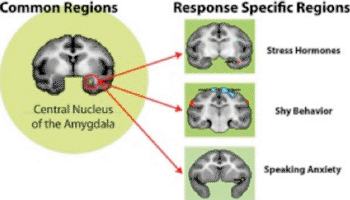Brain Origins of Variation in Pathologic Anxiety Discovered
By LabMedica International staff writers
Posted on 11 Apr 2013
New imaging research with rhesus monkey studies suggests that an overactive core circuit in the brain, and its interaction with other specialized circuits, explains the diversity of symptoms seen by patients with severe anxiety. Posted on 11 Apr 2013
In a brain-imaging study published online before print on March 28, 2013, in the journal Proceedings of the National Academy of Sciences of the United States of America (PNAS), researchers from the University of Wisconsin School of Medicine and Public Health (Madison, USA; www.med.wisc.edu) revealed research that for the first time provides an understanding of the fundamental causes of clinical variability in anxiety disorders.

Image: The central nucleus of the amygdala is a core feature of anxiety across the presentation of different symptom patterns (left) and works through other selective brain regions that result in the diverse symptoms of extreme anxiety (right) (Photo courtesy of the University of Wisconsin School of Medicine and Public Health).
Using a well-established nonhuman primate model of childhood anxiety, the scientists identified a core circuit that is persistently overactive in all anxious individuals, regardless of their particular pattern of symptoms. They also identified a range of more specialized circuits that are over- or underactive in individuals prone to particular symptoms, such as chronically high levels of the stress hormone cortisol.
“These findings provide important new insights into altered brain functioning that explain why people with anxiety have such different symptoms and clinical presentations, and it also gives us new ideas, based on an understanding of altered brain function, for helping people with different types of anxiety,” remarked Dr. Ned Kalin, senior author, chair of psychiatry and director of the Health Emotions Research Institute. “There is a large need for new treatment strategies, because our current treatments don’t work well for many anxious adults and children who come to us for help.”
Major anxiety-related symptoms in the research were measured in 238 young rhesus monkeys using behavioral and hormonal measurement procedures similar to those routinely used to assess extreme shyness in children. Young monkeys are perfectly suited for these studies because of their similarities in brain development and social behavior, Dr. Kalin noted. Variation in brain activity was quantified in the monkeys using fluorodeoxyglucose (FDG)-positron emission tomography (FDG-PET) imaging, a modality that is also used in humans.
Combining behavioral measures of physiologic measures of the stress-hormone cortisol, shyness, and brain metabolic imaging, co-lead authors Dr. Alexander Shackman, Andrew Fox, and their collaborators demonstrated that a core neural system marked by increased activity in the central nucleus of the amygdala was a consistent brain signature shared by young monkeys with chronically high levels of anxiety. This was true in spite of striking differences across monkeys in the predominance of specific anxiety-related symptoms.
The Wisconsin researchers also showed that young monkeys with particular anxiety profiles, such as high levels of shyness, showed changes in symptom-specific brain circuits. Finally, Drs. Shackman, Fox, and their colleagues found evidence that the two kinds of brain circuits, one shared by all anxious individuals, the other specific to those with particular symptoms, work together to generate different presentations of pathologic anxiety.
The new study builds upon earlier work by the researchers demonstrating that activity in the amygdala is strongly shaped by early-life experiences, such as social interactions and parenting. They theorized that extreme anxiety stems from difficulties with the normal maturation of brain systems involved in emotional learning, which suggests that anxious children have difficulty learning to effectively regulate brain anxiety circuits. Combined, this type of research sets the stage for improved strategies for preventing extreme childhood anxiety from blossoming into full-blown anxiety disorders.
“This means the amygdala is an extremely attractive target for new, broad-spectrum anxiety treatments,” said Dr. Shackman. “The central nucleus of the amygdala is a uniquely malleable substrate for anxiety, one that can help to trigger a wide range of symptoms.”
The research also suggests more specific brain targets for different symptom profiles. Such therapies could range from new, more selectively targeted medications to intensive therapies that seek to retrain the amygdala, ranging from traditional cognitive-behavioral therapies to training in mindfulness and other techniques, Dr. Shackman noted. To clarify additionally the clinical significance of these observations, the laboratory is conducting a parallel study in young children suffering from anxiety disorders.
Related Links:
University of Wisconsin School of Medicine and Public Health














